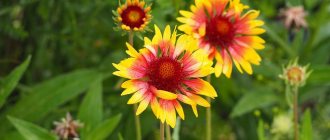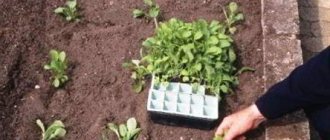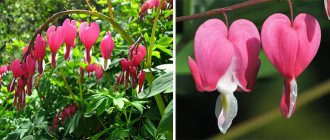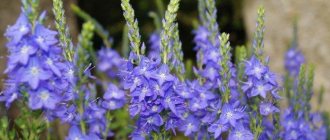Growing vines in garden plots is practical; in the summer you can hide blemishes and unattractive areas, etc. One of these vines is calistegia, or French rose, bindweed, and birch.
Author of the article
Maxim Sverchkov
Professional biologist and breeder with extensive experience and experience.
Description of the plant
With not the most powerful stems (the usual thickness rarely exceeds 4 mm), calistegia has an impressive root, extending horizontally up to 1.5 meters. In garden plots, if it is not limited in the ground by metal or other barriers, the loach is quite capable of escaping far beyond the boundaries of its allotted place, turning into a harmful weed.
The flowers grow singly from the leaf axils and range in color from pale pink, almost white, to deep pink. The size of the corolla in different breeds can range from 3 to 7 cm in diameter.
The oblong leaves are similar to grape leaves, although they are two to three times smaller in size. The vines' vines are capable of clinging to their tendril-like leashes and rise to a height of up to 4 meters, and with good soil under the roots they are able to cover their favorite objects with a continuous carpet.
Application of calistegia
Most often, calistegia (if these are inexpensive or just wild varieties) is planted to hide a not very good view of a barn, fence, or some kind of outbuilding. More noble varieties are settled on verandas, gazebos, or simply on decorative trellises specially placed for this purpose.
Calistegia is an irreplaceable plant in this regard: in the first year of life, if its cuttings are planted densely enough, it is capable of covering any flaws in the landscape with a solid green blanket.
Terry calistegia: types and varieties for open ground
Fluffy
Country of origin: China. The stem of the vine is long, capable of climbing to a height of up to 4 meters; the vascular system of sap ducts in the body of the vine cannot cope further. In winter, during frosts, the ground with roots should be covered with a layer of fallen leaves. The flowers are large, in the form of double bells, the diameter of the inflorescence can reach 9 cm.
Hairy
In Russia it lives throughout the Far East. The shortest type of calistegia, the length of the vine does not exceed 80 cm. The foliage is yellow-green, flowers with fused petals, flat-bell-shaped, pale pink, with a corolla diameter from 3 to 6 cm.
Fence
The fastest growing species. Similar to a young birch tree in the shape of its branches and leaves. It reproduces by self-seeding, and in a couple of years it is capable of entwining everything it can cling to with long tendrils. Refers to weeds.
The leaves are triangular, leathery, the length of the vine is up to 3 m, the flowers are white or with a subtle pink tint. Capable of crossing with other types of calistegia.
Multiplex
Liana with a stem length of up to three and a half meters. A decorative look that is not afraid of severe frosts. The stem dies off in the winter, but this calistegia shoots out from the roots a month and a half before its maximum growth.
The leaves are ordinary, triangular, slightly cut. The flowers are pink, double, with a pearlescent sheen, up to 9 cm in diameter. They are long-blooming - from July to October.
Ivy or Japanese
Belongs to medium-sized varieties, the vine rarely grows to 2.5 m. Flowering lasts from mid-July to September, by which time growth stops. The usual flower size is from 7 to 9 cm, the leaves are medium sized, bright green.
How to properly care for a plant
Loose garden soil with a high content of nutrients is suitable for growing the plant. Calistegia is wary of excessively wet soil, so there should be no nearby groundwater on the site. The obvious advantage of calistegia is the possibility of flowering already in the initial year of planting.
Care Tips:
It is fundamentally important that the area being planted has sufficient ventilation and that the soil is perfectly permeable to oxygen. Watering regime should be moderate
The plant can fully survive short-term drought. The whole care for calistegia is contained in the timely collection of dried flowers. This should be done three times a month, since dried inflorescences spoil the appearance of the plant and interfere with the upcoming flower buds. In addition, it is fundamentally important to thin out the vines and direct their growth, creating a neat shape. Calistegia can grow in the same place for up to ten years. It is precisely on this basis that you need to feed the plant often – once seven days. A simple complex mineral fertilizer is suitable for this. In addition, fertilizing in the form of ash is perfect. In summer it is possible to feed calistegia with mullein. The plant responds well to fertilization, the vines begin to grow before our eyes, and the flowering becomes denser. Calistegia is a winter-hardy plant. In most cases, in winter its stems die off and wake up with the onset of hot weather. For wintering, the plant can be covered with dry leaves or moss. But this should only be done during harsh and non-snowy winters. Calistegia cannot be replanted in the summer, since it may die during active development. Autumn is a good time for replanting. In most cases, calistegia should be replanted once every ten years. It is fundamentally important to take into account that the plant can grow very large and absorb nearby growing flowers; therefore, it should not be placed near front gardens and flower beds. The roots of the plant are immersed in the soil to a depth of about 15 cm; up to three plants can be used per restrictive container. The roots need to be carefully straightened, moistened and covered with soil.
Planting in open ground
Landing dates
Root shoots of calistegia can be planted in early spring or late autumn, shortly before snowfall.
But in the second case, it is necessary to insulate the ground with mulch in the form of fallen leaves, spruce branches, straw, peat, etc. In the spring it can be propagated by cuttings. To do this, cut off the stems with three to four buds and leave 2-3 top leaves. The place of the lower cut is treated with a root formation stimulator (“Kornevin” or the like), dried for about an hour and water is added until the cuttings release roots.
Only wild plants reproduce by seed material; hybrid forms have sterile seeds.
Choice of location and lighting
The planting site is chosen next to any vertical wall to which the plant can cling with its tendrils. Calistegia can attach to trees only if its trunk diameter does not exceed 8-10 cm. Or its bark should have deep vertical and rough grooves.
The best option would be special trellises, strings stretched near the fence from bottom to top, or lattice structures of gazebos or verandas.
Illumination plays a greater role in cultivated forms, although none of the representatives of this family, even the most unpretentious, will want to grow in the shade. If a plant has settled in the shade of a tree, you can immediately say with confidence that the crown of such a tree is openwork and the shade is appropriate.
Soil preparation
Liana loves loamy and sandy soil. You just need to provide annual feeding with compost and mineral fertilizers - this is especially important for cultivated varieties. The close occurrence of groundwater is unacceptable, even seasonal (after the snow melts in the spring)
Landing rules
A groove is dug to the depth of the bayonet of the shovel. It is filled with a mixture of loose soil with ash and humus, as well as with the addition of a mineral complex. Rooted cuttings are planted in the holes made at a distance of 5 to 15 cm from each other, depending on the type of calistegia.
Then, at a distance from the planting, to a depth of 40-45 cm, vertical sheets of slate are dug in, which will prevent the plant from turning into a weed and filling the entire space of the garden or vegetable garden.
Sometimes they even cut iron barrels - a 200-liter barrel is stripped of its bottom and lid, sawed crosswise in half and dug into the ground in this form (rings), planting 5-10 cuttings inside. Their horizontal roots will definitely not escape from such a trap!
Planting and caring for calistegia
- Flowering: from June to September.
- Planting: planting parts of the rhizome in pots - in March, planting seedlings in open ground - in mid-May.
- Lighting: in the morning – bright sun, in the afternoon – partial shade.
- Soil: loose, nutritious loamy, peat or deciduous soil.
- Watering: moderate and only during drought.
- Feeding: from May to September 2 times a month with mineral fertilizer at the rate of 1 tablespoon per m² of area.
- Pruning: throughout the season as needed.
- Reproduction: only by parts of the rhizome.
- Pests: slugs.
- Diseases: powdery mildew.
Read more about growing calistegia below.
Outdoor care
Watering
The plant drinks water very sparingly; as a rule, it has enough water from rain. Abundant watering is only needed in dry summers, and in excessively rainy summers the bindweed can even die from root rot.
Feeding and fertilizer
Fertilizers can be applied during the entire growth period. But especially intensive application can be done in the spring, as the root system forms and the calistegia gains green mass. During the flowering period, moderate feeding is required. Before wintering, it is advisable to mulch the soil in the planting area with wood ash.
Bloom
Flowering begins as early as the year of planting and in some species can last from the beginning of July until frost. The splendor of flowers depends mainly on lighting conditions; the more light, the more magnificent and brighter the flowers. Removing or not removing dried flowers does not affect the well-being of the vine, it is only a matter of aesthetics.
Trimming
The plant is an annual, so the entire vine from the root node to the top dies in late autumn. At this time, sanitary pruning is done, removing the whip from the root, and burning it. In the spring, weak shoots that are lagging in growth are also pruned.
Sometimes you have to do pruning and roots - if they managed to “escape” the restrictive barriers.
Transfer
This process is not mandatory, and is used only if the owner of the site needs to change the location of the flower. Here you will have to work hard: calistegia of all varieties is an extremely tenacious resident of the garden, and you can’t just uproot it.
And in order for the transplanted plant to take root safely in a new place, only the root system is transplanted, and then in the fall: calistegia tolerates summer transplantation very poorly.
Possible difficulties in growing
The biggest difficulty is restraining the active growth of the Calistegia root system. If left unchecked, it can capture a significant territory, which will subsequently be extremely difficult to clear. The most effective way to contain the green “aggressor” is to create an underground fence. In addition, do not neglect regular pruning of branches.
The second possible problem is an invasion of slugs and snails, which not only cause harm to the plant, but also spoil its appearance with their presence. Timely spraying with pesticides can rid Calistegia of uninvited guests.
You also need to remember that Calistegia is poisonous; if the leaves are swallowed (relevant if there are small children in the family), it can cause diarrhea, vomiting, and severe pain in the abdominal area. Otherwise, this unpretentious plant will not cause any trouble for the gardener, provided he follows the basic rules for caring for Calistegia.
Protection from pests and diseases
The plant has good natural immunity. The only disease to which it may be susceptible is fungal infections of the roots in years with heavy rainfall. Then you need to remove the diseased parts, and treat the plants themselves with fungicides. And provide conditions. In which the soil will not become waterlogged.
Of the parasites, it is affected by spider mites - which happens, on the contrary, in dry years. The fight against them is the use of insecticides.
Sometimes the vine is attacked by garden snails or slugs. These are collected by hand, and broken eggshells are scattered around on the soil.
Mr. Summer resident warns: problems with growing calistegia and its pests
When growing Calistegia, various problems arise, complicated by pest attacks:
- Rapid growth of the root system. If the part of the rhizome with young shoots is not dug up in a timely manner, the plant turns into a weed, which is removed with great difficulty. To prevent this, a growth limit is set. Its role is played by an ordinary lattice, dug into the soil or tripods.
- Slugs. If such pests are found on a plant, then the soil around the flower is sprinkled with lime. The plant is also treated with an insecticide such as Groza.
- Spider mite. During hot weather, such insects also appear on the foliage. They are eliminated with acaricidal agents like Aktara.
Reproduction
Reproduction is vegetative, mainly using rooted shoots or root segments with buds.
Root propagation, subject to antiseptic rules, is practiced throughout the growing season. The cuttings are rooted in a peat-sand mixture, and to create a greenhouse effect they are covered with cut-off parts of plastic bottles upside down.
Autumn care, shelter
Only plants one or two years old need protection from winter cold. Older, fairly rooted plants survive frosty periods without problems.
Features of perennial
The plant is used mainly for landscaping vertical surfaces. It will help you quickly and beautifully decorate fences and unsightly walls in your garden.
The main advantages of calistegia:
- The plant is not yet very common in the world of gardening, so calistegia attracts attention with its originality.
- The flowers have a very beautiful pink tint, which looks impressive against the background of the stems of the green vine.
- Flowering lasts for quite a long period - from July to September, so calistegia will decorate the garden almost the entire summer period.
- The plant is unpretentious and caring for it is not difficult.
- The rapid growth of calistegia will be able to realize all design ideas for landscaping the site in the shortest possible time.
Calistegia really loves light areas. Thanks to the light, flowering begins earlier and lasts longer. You can plant the plant in partial shade, but it is important to understand that growth will be worse.
Since the plant can grow up to three meters per season, it is worth prudently taking care of an underground barrier that will prevent the calistegia from growing excessively. To do this, it is enough to plant the plant in a container without a bottom, which should be at least forty centimeters deep. The soil must be loosened before planting; it must allow water and oxygen to pass through well. In addition, it is advisable to install supports, thanks to which the plant will grow. This can be ordinary wire or mesh, the diameter of which should not be more than ten centimeters.
Calistegia in landscape design
The ideal solution for using calistegia in landscape design is the organization of hedges that visually expand the space. For this purpose, the technique of an arch passage between different zones of the site is often used.
Solid, but sometimes with breaks, green walls can hide unattractive elements of the landscape (most often man-made, which do not fit well into the architect-designer's plan). For this purpose, spring planting of cuttings or sections of rhizomes with growth buds is planted at a distance of 5 to 10 cm from each other.
When arranging a solid wall, remove other flowers from the proximity of bindweed - it will not allow anyone to grow and will drown out any extraneous phytoactivity.











